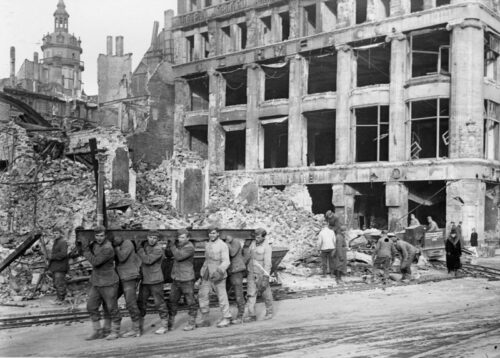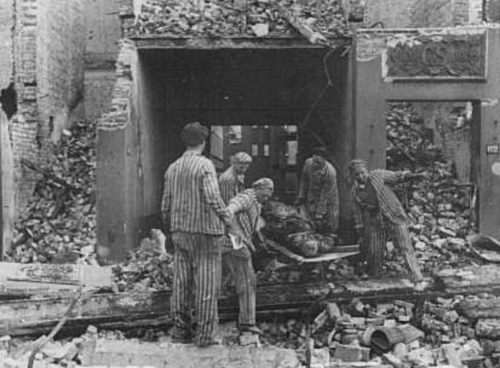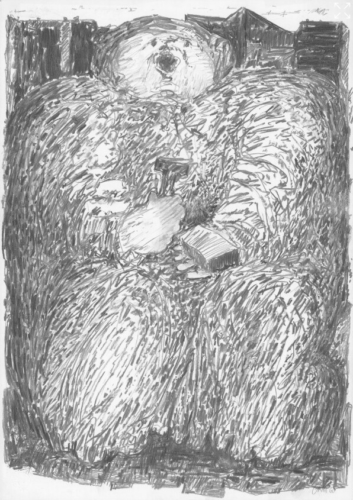A poem from the book Gleisdreieck (1960) by Günter Gras, speaks to the peculiar state of mythical German women tasked with clearing the rubble of WWII.
Gnade Gnade.
Die große Trümmerfrau…Amen Amen.
Hingestreut liegt Berlin.
Staub fliegt auf,
dann wieder Flaute.
Die große
Trümmerfrau wird heiliggesprochen
That last line translates roughly as “Rubble woman is canonized”.
The “canonized” angle of the Trümmerfrau is interesting because they actually were a tiny and insignificant group of reluctant volunteers.
The historian concedes that, of course, the builders needed help – after all, about 400 million cubic meters of rubble and ruins were waiting to be cleared across the nation. “But women played a minor role in clearing German cities from the rubble,” Treber says. Berlin mobilized about 60,000 women to clear the war ruins, but even that amounted to no more than 5 percent of the female population – it wasn’t a mass phenomenon. In the British Sector, Treber says, only 0.3 percent of the women joined in the hard work. Yet it wasn’t just the women who were reserved when it came to clearing the war debris; men weren’t crazy about the task, either. In the eyes of the Germans, it was anything but honorable for people to show their “willingness to rebuild.” In fact, most Germans regarded clearing rubble as punishment – and for a reason. During the war, the Nazis made soldiers, the Hitler Youth, forced laborers, prisoners of war and concentration camp prisoners clear the bombed cities after Allied air raids.
This checks out when you read American military history of occupation after the war. In fact, while a number like 60,000 sounds large, first-person accounts explain what they actually worked on in terms of an entire country reduced to rubble.
“We had 20,000 (people) per shift and we worked 24 hours a day with lights, generator sets — so there were 60,000 people,” Delbridge said. “We had more women than men that did all of the earth moving… and they moved the earth by hand.” In all, records from the U.S. Army Corps of Engineers, Office of History estimate that more than 9.8 million work hours went into the [Tempelhof Airstrip] effort between military personnel and local Germans. Local Germans – mostly women according to Delbridge – accounted for the vast majority of that figure (more than 9.6 million work hours).
Thus it was 60,000 people, mostly women, who had cleared and built one airstrip. Undoubtedly an important project, yet that was just one airstrip.
For another simple number check, during WWII the Nazis deported 75,000 people into Leipzig to do forced labor including punishing rubble removal as “Ostarbeiter”.

The mostly forgotten “Ostarbeiter”, despite numbering far more than the Trümmerfrau, was in addition to the large slave labor supply out of Buchenwald concentration camps.
Here’s another typical image courtesy of Hamburg almost completely erased by the “big” Trümmerfrau story.

Thus, a subset of 60,000 people clearing all of Berlin seems to NOT add up. It is dwarfed by the bigger picture of who removed rubble and when. One important airstrip indeed could be credited to tens of thousands of Trümmerfrau by the U.S. military, but what does that really represent about Berlin’s reconstruction?
…in a voluntary recruitment drive in Duisburg in the West German industrial Ruhr-area in December 1945, 10,550 men volunteered — and 50 women. Such evidence suggests that when they were not compelled to do so, German women did not volunteer in great numbers. […] The divided city of Berlin was a special case. Here, large numbers of women did clear rubble — about 26,000 women in total, and the term Trümmerfrauen originated in West Berlin. This large number was due to the fact that women far outnumbered men in Berlin — in the age group 20–39, there were 250,000 men and 500,000 women in Berlin in 1947.
Perhaps the thing that rings most hollow is how the German narrative tried to frame Nazi women after WWII as suffering hard labor, at the very same time that concentration camps were being fully investigated.
As a young woman who had grown up almost exclusively under the Third Reich, Frau Naß admits the end of the war threw all her beliefs into question: “We were totally disillusioned, because as girls we had gone through the Hitler Youth,” she says. “You have to imagine how you would react if the whole system you had been brought up in simply didn’t exist anymore. People just couldn’t grasp it.”
The lack of slaves?
Hard work really hit the Nazi girls hard, I guess, when they realized they couldn’t expect Hitler’s promises of slavery to work for them anymore. Their dream of easy living through slavery wasn’t easy to let go of apparently, and some say we should appreciate them more for it.
The suffering of these women isn’t even appreciated.
Here’s a good description of what is meant when “the whole system you had been brought up in simply didn’t exist anymore“:
Not only were the women not volunteering to help in the rebuilding, the men weren’t signing up either. It was not seen as honorable to help rebuild. In fact, it was considered punishment. The reason for that lies in the fact that the Nazi party forced soldiers, Hitler Youth, prisoners of war and concentration camp prisoners to clean up the rubble in Berlin during the war. After the war, the authorities began using prisoners of war and former members of the Nazi party. Only when progress was insufficient using those forced laborers did the country turn to the general population for help. In the West, the help was voluntary…. Berlin encouraged participation by making the second-highest category of food ration cards available to the Trümmerfrauen. They showed images of smiling women cheerfully lugging stones and bricks. The image was repeated so many times, it is ingrained in the German collective consciousness.
A small group of reluctant volunteer women, only showing up for highly valuable ration cards, seems to be what became an ingrained German propaganda image of willing hard workers. Was it meant to be a subtle nod back to arbeit macht frei?
Some have started to study whether such propaganda was a calculated effort by Nazis after they surrendered to coldly erase the memory of those who had suffered actual hard labor under their tyranny. A strange irony is emerging. Clearing rubble was punishment to be avoided by German women, until “canonization” for hard work was on the table and then suddenly it was appropriated by them as a symbol of pride.
The focus of this research project is to investigate the Austrian “Trümmerfrauen”-myth as the idea that the removal of debris after World War II in Vienna was mainly done by voluntary female workers. To this end, previously unprocessed holdings of the Wiener Stadt und Landesarchiv will be systematically recorded and analyzed for the first time. From these holdings it becomes clear that the work in Vienna was primarily done by former National Socialists who were compelled by law to work. …this expiatory work by former NSDAP members could give rise to the Austrian “Trümmerfrauen”-myth decades later.
